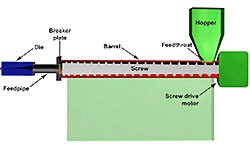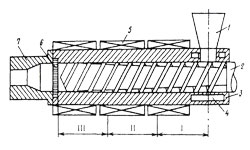Types Of Plastic Extruders
Introduction
Plastic extruders are used to create a wide range of items, including plastic tubing, trims, seals, plastic sheets and rods. Extruder is the machine for producing more or less continuous lengths of plastic sections out of a selected type  of plastic resin. There are a number of extrusion techniques available such as co-extrusion, offset extrusion, oriented extrusion, overcoat extrusion, cold extrusion, ram extrusion and much more. of plastic resin. There are a number of extrusion techniques available such as co-extrusion, offset extrusion, oriented extrusion, overcoat extrusion, cold extrusion, ram extrusion and much more.
The essential elements for a thermoplastic extruder are a tubular barrel, usually electrically heated; a revolving screw, ram or plunger within the barrel; a hopper at one end from which the material to be extruded is fed to the screw, ram or plunger; a die at the opposite end for shaping the extruded mass. Extruders may be divided into three general types :
- Single Screw Extruder
- Twin or Multiple Screw Extruder
- Ram Extruder
Single screw extruders and twin screw extuders are the most widely used extruders. The screw that is used to push the resin out of the die is the important component of a screw extruder. In the earlier days rubber screw were used but the rubber screw was not able to give enough amount of shear into the polymer. Therefore, screws were designed that would start deeper in the feed and gradually taper shallower in the metering section to apply more work on the polymer as it was going from the feed to the discharge.
Basic screw design: The screw is usually contained inside a tight fitting barrel driven by a variable speed motor and gearbox. It is a highly efficient device capable of processing several tons of plastic per hour, even in modestly sized extruders. The screw is divided into three division the feed section, the compressor and the metering section.
The feed section of the screw mechanism stores and delivers resin pellets from a gravity fed hopper into the jacketed screw to begin the plastic longitudinal movement. Screw threads move the plastic using axial rotation. Within the barrel, heaters help the plastic develop a tack to increase its friction against the barrel wall. Without this friction the plastic could not be conveyed forward and would merely rotate inside the screw.
In the transition or melt stage, the root diameter of the screw increases while the height of the flight decreases. The  resin is melted here because of compression, shearing and heating produced in the barrel. Now the melt moves to the metering section, where the screw diameter remains constant. The melted plastic which is under high pressure now is pumped into the extruder die. resin is melted here because of compression, shearing and heating produced in the barrel. Now the melt moves to the metering section, where the screw diameter remains constant. The melted plastic which is under high pressure now is pumped into the extruder die.
Barrier Screws: The resin is sometimes not completely melted in the basic extrusion screw. The barrier screw in designed to counter this problem. Additional flights are attached to the transition section so as to separate molten and solid plastic to different channels. As the solid pellet moves forward it melts due to shear against the wall and thus melts and flows into the liquid channel. Thus the solid channel narrow gradually and the liquid channel widens.
Mixing Screws: When mixing two different additives, a more efficient way is to mix extrusion materials with twin screw extruder. In this method two screw rotate with or against each other and have special mixing features, such as kneading blocks and forward and reverse capabilities. Some single screw systems can, however, be used for mixing.
Though general-purpose screws are available, different plastics require differently calibrated extrusion screws. The length-to-diameter ratio, pitch, length of each zone and helix angles of a screw must all be matched to the plastic type being used. The screw must also be designed to suit a specific type of die.
Extrusion screw design has been improving over the years, with new innovations and ideas that help in perpetually adjusting the process so as to meet the needs of specific applications.
|
|